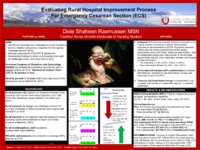The Graduate Nursing Project collection includes Doctor of Nursing Practice (DNP) Scholarly Projects and Master's students' non-thesis projects submitted as part of program requirements.
TO
- Graduate Nursing Project, Doctor of Nursing Practice, DNP18
- Graduate Nursing Project, Doctor of Nursing Practice, DNP, Acute Care, Poster4
- Graduate Nursing Project, Doctor of Nursing Pract, DNP2
- Graduate Nursing Project, Doctor of Nursing Practice, DNP, Neonatal, Poster2
- Graduate Nursing Project, Doctor of Nursing Practice, DNP, Poster2
- More
| Title | Creator | Date | Description | Relation Is Part Of | ||
|---|---|---|---|---|---|---|
| 26 |
 |
Timely Cervical Collar Removal at a Level 1 Trauma Center | Teas, Molly | 2018 | POSTER | Graduate Nursing Project, Doctor of Nursing Practice, DNP, Acute Care, Poster |
| 27 |
 |
Code Stroke: Effects of a Protocol Revision: A Quality Improvement Project | Graham, Patrick J. | 2018 | Introduction: Acute strokes in the inpatient setting comprise 6-15% of all strokes annually and are associated with worse functional outcomes and a larger financial burden than those with outpatient onset (Blacker, 2003; Cumbler, 2015; Bekelis, Missios, Coy, & Mackenzie, 2016). Approximately 32,000 ... | Graduate Nursing Project, Doctor of Nursing Practice, DNP |
| 28 |
 |
Cervical Collar Removal Times at a Level 1 Trauma Center: A Needs Assessment | Teas, Amelia H. | 2018 | Trauma patients remain in cervical collar neck braces for up to 12 hours awaiting final radiology readings. These final readings are necessary before the collar can be removed. The extended wearing of cervical collars potentially leads to worsening fractures, ligamentous injury, increased spinal mov... | Graduate Nursing Project, Doctor of Nursing Practice, DNP |
| 29 |
 |
One Year Review of Experience with Postpartum IUD Insertions | Radmall, Jessica | 2018 | Aims: This quality improvement project aimed to understand postpartum contraceptive initiation trends in a midwifery practice at a teaching hospital in the Intermountain West. The primary aim was to measure the uptake of intrauterine device (IUD) and other long-acting contraception (LARC) in this po... | Graduate Nursing Project, Doctor of Nursing Practice, DNP |
| 30 |
 |
Timely and Safe Removal of Backboards in a Rural Emergency Department | Garrett, Craig | 2018 | This study explored the need for timely and safe removal of backboards in a rural emergency department where no guidelines or protocols were currently in place for patients being brought in on backboards. Studies indicate adverse effects on patients who are allowed to have prolonged backboard time b... | Graduate Nursing Project, Doctor of Nursing Practice, DNP |
| 31 |
 |
Identifying Strategies to Decrease ED Boarding | VansCoy, Darrin | 2017 | POSTER | Graduate Nursing Project, Doctor of Nursing Practice, DNP, Poster |
| 32 |
 |
Delayed Antibiotic Prescribing in Primary Care | Laack, Jessie | 2017 | POSTER | Graduate Nursing Project, Doctor of Nursing Practice, DNP, Poster |
| 33 |
 |
Evaluating Rural Hospital Improvement Process For Emergency Cesarean Section (ECS) | Rasmussen, Dixie Shaheen | 2017 | POSTER | Graduate Nursing Project, Doctor of Nursing Practice, DNP, MS to DNP, Poster |
| 34 |
 |
Brain Code: A Standardized Response to a Neurological Emergency | Szemak, Erin | 2017 | POSTER | Graduate Nursing Project, Doctor of Nursing Practice, DNP |
| 35 |
 |
Delayed Antibiotic Prescribing in Primary Care | Laack, Jessie | 2017 | Prescribing antibiotics for self-limiting upper respiratory infections is unfortunately common practice among primary care providers (PCP) in the US. Inappropriate use of antibiotics leads to the formation of resistant organisms, which have been increasing worldwide. Delayed antibiotic prescribing (... | Graduate Nursing Project, Doctor of Nursing Practice, DNP |
| 36 |
 |
Ottawa Guidelines Implementation for a Local Government Run Hospital | Cluff, David | 2017 | The incidence of lower extremity injury that present to emergency departments in the United States yearly is unknown. But, due to the high numbers of lower extremity injuries seen at Emergency Departments (ED), overutilization of resources such as radiology can occur. Approximately 30% of patients r... | Graduate Nursing Project, Doctor of Nursing Practice, DNP |
| 37 |
 |
Brain Code: A Standardized Response to a Neurological Emergency | Szemak, Erin | 2017 | Intracranial hypertension (IH) is a neurological emergency that can lead to profound disability and death and is consequently referred to as a brain code. Intracranial hypertension is the sequelae of typical acute care diseases or injuries such as stroke, traumatic brain injuries (TBIs), and hepatic... | Graduate Nursing Project, Doctor of Nursing Practice, DNP |
| 38 |
 |
Identifying Strategies to Decrease ED Boarding | VansCoy, Darrin | 2017 | Keeping patients in the emergency department (ED) after an admission decision has been made, also known as ED boarding, leads to ED overcrowding. Boarded patients continue to use ED resources and prevent new patients from being seen. Boarding can also have adverse effects, such as higher mortality r... | Graduate Nursing Project, Doctor of Nursing Practice, DNP |
| 39 |
 |
Can a Rural Hospital Reliably Preform an Emergency Caesarean Section in Less Than Thirty Minutes? | Rasmussen, Dixie Shaheen | 2017 | This project was designed to identify and evaluate key challenges a rural hospital has in providing a reliable best practice response, analyze newborn outcomes and disseminate findings to other rural hospitals that might be challenged when confronted with an Emergency Caesarean Section (ECS). Rural ... | Graduate Nursing Project, Doctor of Nursing Practice, DNP |
| 40 |
 |
Implementing a Fast Track | Burton, Kassie | 2016 | Over the past 10 years there has been an increase in the number of emergency room visits. From 1993 to 2013 the number of Emergency Departments in the United States has dropped by more than 500 (AHA, 2013). These changes have caused an increasing overcrowding problem; many researchers have categoriz... | Graduate Nursing Project, Doctor of Nursing Practice, DNP |
| 41 |
 |
Heart Failure Self-Management Education: Does Timing Have an Impact on Readmission Rates? | Clayton, Anne | 2016 | Hospital readmissions are expensive but relatively common among heart failure (HF) patients. Studies have found that teaching patients self-management strategies to use at home, including early reporting of symptoms, can help to prevent hospital readmissions. Therefore, identifying and implementing ... | Graduate Nursing Project, Doctor of Nursing Practice, DNP |
